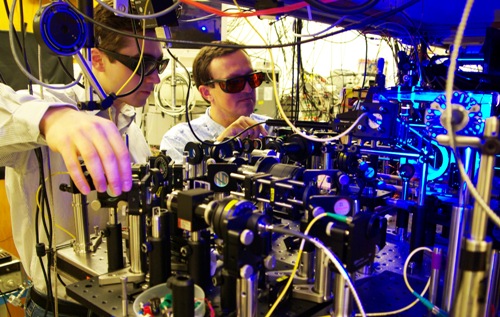Georgia Tech professor Alex Kuzmich and graduate student Yaroslav Dudin have devised a new faster and more-efficient technique based on a phenomenon called Rydberg blockade to generate single photons that can be utilized to explore the disorder and dynamics in specific physical systems and in optical quantum information processing.
 Georgia Tech graduate student Yaroslav Dudin and professor Alex Kuzmich adjust optics as part of research into the production of single photons for use in optical quantum information processing and the study of certain physical systems. (Credit: Georgia Tech Photo: John Toon)
Georgia Tech graduate student Yaroslav Dudin and professor Alex Kuzmich adjust optics as part of research into the production of single photons for use in optical quantum information processing and the study of certain physical systems. (Credit: Georgia Tech Photo: John Toon)
Kuzmich and Dudin have been working on quantum information systems that are based on mapping of atomic information onto confined photon pairs. They used Raman scattering technique for this research. However, this technique was inefficient to generate the required number of confined photons for complex systems. To overcome this issue, they have developed the new technique.
The new technique leverages the novel properties of atoms, which have one or more electrons in the Rydberg state. These highly excited atoms have a principal quantum number over 70, demonstrate powerful electromagnetic properties, and interplay strongly with each other. These properties of a Rydberg atom prevent the generation of additional Rydberg atoms within a region of 10-20 µm due to the Rydberg blockade phenomenon. This single Rydberg atom is then transformed to a photon, thus ensuring the generation of one photon from a rubidium ensemble comprising numerous densely-packed atoms.
The researchers produced the Rydberg atom by irradiating a cloud of hundreds of laser-cooled rubidium 87 atoms entangled in an optical lattice, using lasers. The irradiation excited a single atom from the whole ensemble into the Rydberg state. At this state, the Rydberg blockade phenomenon prevents the generation of additional Rydberg atoms by modifying the atomic level energies, thus producing only one Rydberg atom. Since Rydberg atoms demonstrate strong interaction within an area of 10-20 µm, the researchers restricted the volume of their cloud of rubidium atoms, thus ensuring the formation only one Rydberg atom from the ensemble.
Using an additional laser field, the researchers then converted this Rydberg atom into a quantum light field with the same statistical properties of the Rydberg atom. Dudin informed that this new photon source is thousand folds quicker than current systems. The researchers used Rydberg atoms that have a principal quantum number of roughly 100. The next step is to develop a quantum gate in between light fields.